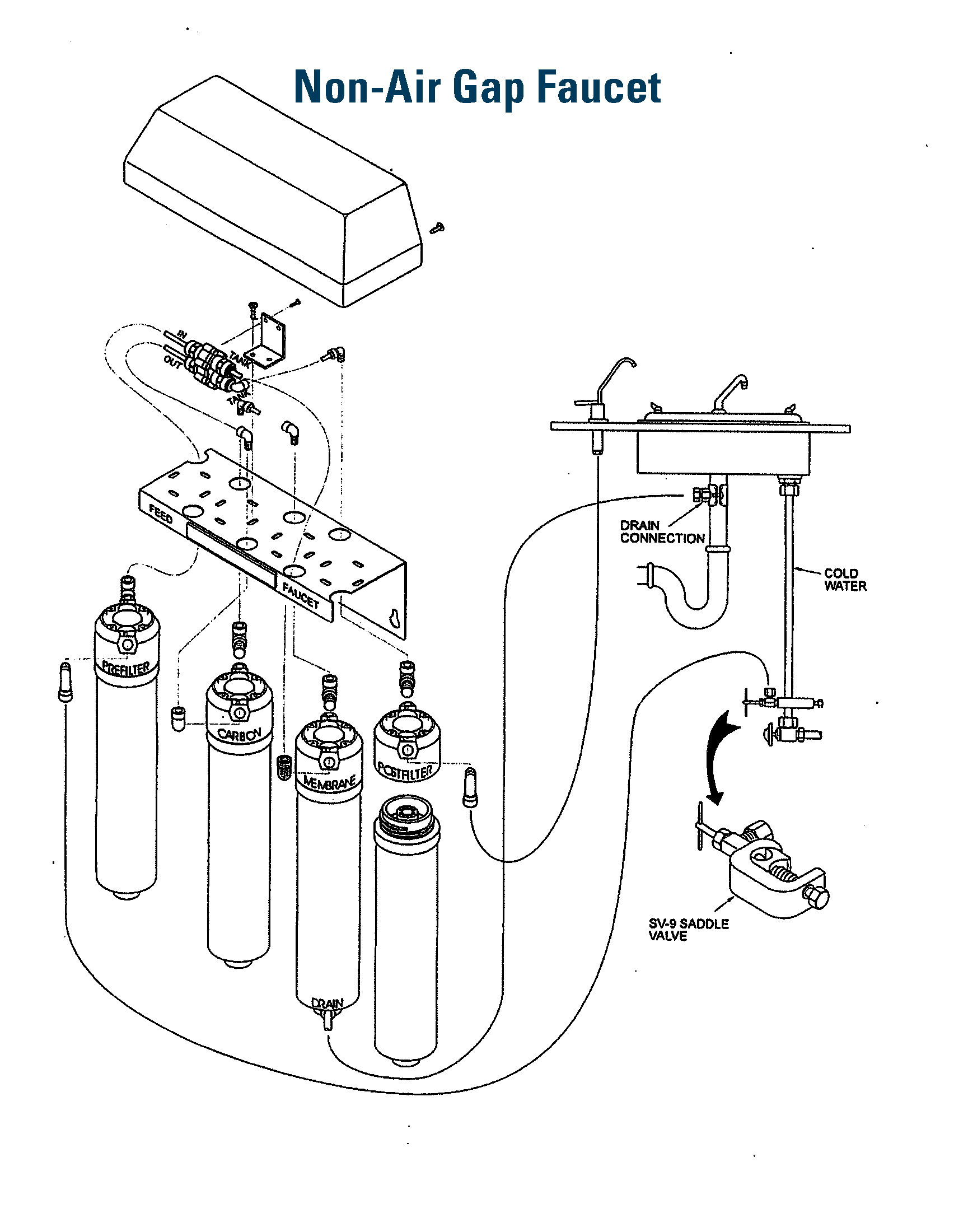What is an Air Gap vs. Non-Air Gap RO Faucet?
What is an Air Gap Faucet?
One common question we're asked is, "do I need an air gap or a non-air gap faucet for my RO system?"
Both Air Gap and Non-Air Gap RO faucets have their advantages and disadvantages. First let's define what "air gap" means.
The air-gap reverse osmosis faucet design came about so that in the event of a sink drain being clogged and backed up, the air gap installed in the RO discharge line would pull a small amount of air rather than the dirty water back into the RO unit.
Similar to how a dishwasher air gap ensures dirty water never re-enters the clean water supply of a dishwasher, an RO air gap faucet prevents dirty water from backflowing into the reverse osmosis filtration system.
Generally, reverse osmosis drinking water systems come standard with an air gap faucet, but many RO system manufacturers will also offer the non-air gap option.
What is a Non-Air Gap Faucet?
Non-Air Gap RO faucets sends the drain line water from the RO membrane directly into the sink drain. A non-air gap faucet only has the drinking water line connected to it.
The main difference between an air-gap and non-air gap faucet is that a non-air gap faucet does not have a physical siphon break from the Reverse Osmosis (RO) system itself and the sink drain.
an air-gap and non-air gap faucet is that a non-air gap faucet does not have a physical siphon break from the Reverse Osmosis (RO) system itself and the sink drain.
Many customers choose to install a non-air gap faucet because they are easier to install (less tubing), and are quieter (less gurgling noise) than the air gap system. See below for the advantages and disadvantages of both RO faucets.
Another option, is to install an RO system like the Microline TFC-400-ESP. Out of the box, the system comes with an airgap and non-airgap faucet connection set-up.
How to Switch an Air Gap Faucet for a Non-Air Gap Faucet?
You can easily switch out faucets.
Keep in mind that an air gap faucet uses 1/4" tubing from the reverse osmosis system to the faucet and 3/8" tubing from the faucet to the drain. A non-air gap typically uses 1/4" tubing from the RO system directly to the drain. To convert, simply take the 1/4" tubing from the system directly to the drain, but may need to find a fitting to reduce the connection from 3/8" to 1/4" to fit the drain line tube now coming directly from the system.
The Pros and Cons of an Air Gap Faucet for RO
| Air Gap Faucet Advantages | Air Gap Faucet Disadvantages |
| System protection: In the event of a stopped up sink drain, the physical line break in an air-gap system ensures that water is not siphoned back into the RO system (which could damage the unit and contaminate the membrane). | Clogging: Small tubing and trough on the air-gap system can cause sediment clogging resulting in water backing up into sink or counter tops |
| Noisy: There's a physical air barrier of water dropping into the trough, Air Gap faucets can make a gurgling sound while the storage tank is being filled. | |
| Difficult installation: Extra tubing and connections makes the installation cumbersome. |
The Pros and Cons of an Non-Air Gap Regular Faucet
| Non-Air Gap Faucet Advantages | Non-Air Gap RO Faucet Disadvantages |
| Lower Cost: Non-air gap systems are generally less expensive than air gap systems. | Potential Damage: Chance that if the drain backs up, the RO system could be damaged, or the membrane contaminated. |
| Less tubing/hoses: A non-air gap unit simply has one water line that goes up to the faucet. | Plumbing Codes: Considered non-compliant for some city/county plumbing codes. |
| Noise: No gurgling sound since the drain line from the RO membrane flows directly into the sink drain line. | |
| Ease of Installation: Fewer connections and tubing allows for easier installation. |
The air gap system routes the unit's drain water upward through a 1/4" flexible tube to a small trough built into the base of the faucet. The water then flows in the non-pressurized trough to the other side of the faucet stem where it falls into a hole and drops by force of gravity into a 3/8" flexible tube which drops it into the under sink drainpipe.
This process requires that the air gap faucet have three tubes rather than one (one for the upward drain water, a second for the downward drain water, and the third for the unit's product water, which you drink). Thus, an air gap faucet must have a wider base and will require a larger hole in the sink or countertop.
Air-Gap Faucet Installation Tips
Installation of an air gap faucet requires a couple of additional steps. The faucet itself has a small hole in its body so that water can flow out onto the sink or countertop should the drain tube become clogged. The hole is part of the air gap device. It must remain open and free of debris. (A faucet without a hole is not an air gap faucet. Inside this hole, waste water goes into the top and out through the bottom. Water drops past the hole into the 3/8" waste line.
Some local plumbing codes allow you to install an in-line check valve in the drain line for backflow prevention. This allows the use of a non-air gap faucet, thereby eliminating the noise associated with air gap faucets. When code allows, the 1/ 4" wastewater line flowing from the system is connected to a 1/4" drain saddle installed on the drain pipe under a sink. This is also a very quiet installation. Air gap faucets can be installed as non-air gap faucets by installing a 1/4" drain saddle. Remove the 1/4" wastewater line out of the reverse osmosis system from the base of the faucet and attach it to the 1/4" drain saddle. Remove the 3/8" drain line from the air gap faucet and discard.
Why are Air Gap Faucets Noisy?
Generally, Reverse Osmosis systems are very quiet -- though you may hear a "gurgling" sound as the "concentrate" or wastewater flows from the membrane to the drain. Reverse Osmosis is designed so that "crossflow" water flushes the contaminated concentrate away from the system. This flushing keeps the unit from fouling.
You might hear additional sounds if you have an air gap faucet as these systems tend to make a gurgling sound as the storage tank is being refilled. Also, as the tank is slowly filling with water, water is also slowly flowing to the drain line under the faucet. This water falls into the "air gap" trough and then flows down to the sink drain. The slow trickle of water often causes a gurgling sound.
Note that if you hear "hissing" noises, you should immediately call your local water treatment professional as there may be a problem with water pressure, the air gap, or a leak.
Shop Faucets Now: When it comes to RO faucets, there are a variety of styles and finishes to choose from whether you select an air gap or a non-air gap faucet.


A small RO filtration system can be installed at the kitchen tap to provide top-quality drinking water. This is called a “point of use” (POU) water filtration system and can also connect to your fridge and ice machine. Water pressure is a consideration with some refrigerators, so be sure to refer to your RO system’s owner’s manual as the pressure from the Reverse Osmosis unit is about two-thirds of the incoming line pressure. Related content: Can I Install a Reverse Osmosis System Myself?
Top-Selling Reverse Osmosis Drinking Water Systems
FAQs
Will an Air Gap Protect my Dishwasher?
An air gap is a device used in plumbing to prevent wastewater from the sink from flowing back into the dishwasher. In some regions it is required as a safety measure to prevent contamination of the dishwasher with dirty water.
The air gap creates a physical break in the plumbing that prevents contaminated water from being siphoned back into the dishwasher.
If you're experiencing issues with your dishwasher, it's important to check the air gap to make sure it is installed correctly and is not clogged. Proper maintenance and cleaning of the air gap can help prevent potential problems. If you have concerns about the impact of the air gap on your dishwasher, it may be helpful to consult with a plumber or appliance technician for a more personalized assessment.





